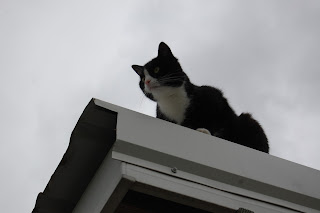― Wendell Berry
Cat on a hot tin roof. Maple got herself on the roof of the barn by herself. She needed help getting down. Silly kitten.
This picture shows how the fence wire is wrapped around a plastic insulator. This is not as easy to do as it might look. This is done on every other insulator. On the 'other' insulator the wire is strung through in a straight line.
Using a piece of special electrical wire, the six pieces of the fence wire are connected to each other. This allows all wires to be electrified. The top picture shows how the wires are connected. The second picture shows the manner in which the wire is connected to the special fence wire.
This shows a portion of the completed fence. The entire field is now enclosed by the electric fence.
The top picture also shows how the ground is cleared on the outside of the fence. The buffer zone is designed to decrease protective cover in which the deer can hide and get closer to the fence.
As you might think, this fence is neither strong enough, nor high enough to keep deer out of the fields. Also, the electrical charge does not provide enough of a shock to the body of a deer to deter it from going through the fence. From this you might wonder, what good is the fence? Well, what you do is take a soda can, cut off the ends and cut the remaining piece in half. You then fold down the top and hook it over a wire. You then smear some peanut butter on the can. The goal is to induce the deer to come close to the fence to eat the peanut butter. When the deer touches the can with their nose/tongue to eat the peanut butter, the electricity running through the wire will shock the deer on the nose/tongue; where the deer is sensitive. The hope is that once shocked the deer will be conditioned to avoid the fence. In the overall scheme of things it is pretty cool how effective this has been over the past two years. The first year there was no damage done by the deer. Last year there was one time when the deer did damage. We will cross our fingers and hope for the best for this coming season.
Good night kitty.
Happy and healthy eating to one and all.


























